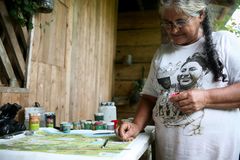
For María Brígida González, one way of processing experiences and remembering the past is through art: her work shows the violent events of the community’s history. Photo: Charlotte Kesl
At daybreak, all appears calm: one observes pigs and dogs slipping between the houses, and periodically a rooster crows, welcoming the sunny, beautiful day. At 5:30am the morning tranquillity ends and it’s time to get up and start working. Soon thereafter the daily tasks of a rural village begin. While the women start oven fires, fill pots with water, and feed their babies, the men find their machetes and prepare them for work in the fields. Children get ready for school. Is this a normal life? Not entirely.
Concern and uncertainty are prevalent in this community, where members share a recent past of sadness and hopelessness. For decades, this community has lived and continues to live in the midst of an armed conflict. Since the 1970s the guerrilla group the Revolutionary Armed Forces of Colombia (FARC) has been present in the region. However, the incursion of paramilitary groups beginning in 1996 escalated the conflict between armed actors and resulted in aggressions directed towards these civilians.(1) But instead of becoming part of the millions of Colombia’s internally displaced population,(2) this community of small farmers came together in 1997 and embarked on a pioneer experiment in the region of Urabá (northwest Colombia): the Peace Community of San José de Apartadó, a community that declared themselves neutral in the armed conflict and rejected the presence of all armed groups on their land.
“We will not give up in the face of these weapons, and we will continue working together […] saying ‘no’ to the war.” These are the defiant words of Jesús Emilio Tuberquia,(3) a representative of the community and a fighting man who, with a pleasant smile, proudly wears his traditional, handmade hat.
This year the Peace Community commemorates 15 years of resistance and struggle. These have been 15 dangerous years during which different actors in the conflict have assassinated 210 members of the community,(4) despite demands from the Inter-American Court of Human Rights that the Colombian government take measures to protect the population.(5) In September 2011, the community was one of three finalists for the Sájarov Prize for Freedom and Conscience awarded each year by the European Parliament to defenders of freedom. This community of small farmers was nominated for “the courage, resistance, and dedication to the values of peace and justice […] in an environment of brutality and destruction.”(6)
Despite the risks, the community continues to strive for normality in its daily life and its internal organisation because, “You have to be very organised to confront war,” says Berta Tuberquia, one of the community’s representatives. After eight years of resisting forced displacement, the return to the villages in the mountains surrounding the town centre of San José de Apartadó began in 2005. This was an important step for the community’s work and the lives of its members who, after several years of displacement, could return to their farms and cultivate banana, cacao, beans, and fruit for their food supply. It was a successful return for several families who, thanks to the internal strength of their organisation and international accompaniment, managed to re-establish their lives in an area where, according to the community, the pressures and explicit threats of displacement continue to this day.(7)
Several hamlets of the community are partially self-sustaining in terms of their food production and have also been able to sell some agricultural products to earn money. Together with other communities, they also founded the Campesino University, an exchange project between rural communities living in the midst of conflict. This project seeks to show that resistance is something that must be carried out every day. Increasing families’ ability to support themselves has also been an important objective.(8) This courage and unending struggle has led to support from the international community, and for Berta Tuberquia, this is one of their most important achievements.
The challenges: the armed conflict and impunity
María Brígida González, a 57 year-old woman with long, braided white hair, lost three brothers and two children because of the war.(9) She uses art to process what she has lived through and preserve the memory of her loved ones. Her paintings show the violent events in the history of the community. “Everyone they killed they accused of being guerrillas,” says the leader.
The event that had perhaps the biggest impact on the community, but also showed their true capacity for resistance, was the massacre of 21 February 2005. On that day eight people were murdered and chopped into pieces in the villages of Mulatos and La Resbalosa. Seven of them were from the Peace Community, among them three children and the historic leader Luis Eduardo Guerra.(10) Former National Army Captain Guillermo Gordillo was sentenced to 20 years in prison for his participation in the 2005 massacre, after having confessed his participation.(11) Ten alleged perpetrators of this massacre, members of the Army, were acquitted, which makes the possibility of true justice in this emblematic case more remote.(12) In fact, the majority of human rights violations committed against the Peace Community remain in impunity.(13)
Another area of concern is the strengthening of illegal armed groups that have regrouped following the demobilisation of the United Self-Defence Forces of Colombia between 2003 and 2006. According to the Jesuit Priest Javier Giraldo, who has denounced the human rights violations that occurred in the community, “that is the main concern because [during 2011] there were more than 11 deaths in the area.” He adds that, “in several cases, the military was present or nearby. There is a lot of complicity.”(14)
In addition, the Peace Community,(15) the Human Rights Ombudsman,(16) and human rights defender and Congressional Representative Iván Cepeda,(17) have called attention to the risk that the civilian population must confront, given the alleged activation of illegal armed groups in the region. Although the stigmatisation, threats, and defamations against the Community continue, they have been able to establish a certain amount of dissuasion toward armed actors thanks to efforts to support their project on an international level.
Fifteen years of resistance. There is still hope that the day will come when the Community can be at peace, watching the sun set in a normal Colombian town after having enjoyed a sunny, beautiful day free from concerns, uncertainties, and fear. Meanwhile, the Community continues to be an historic example for other communities at risk both inside and outside of Colombia.
1 Hernández Delgado, Esperanza: Resistencia civil artesana de paz, Javeriana University, 2004.
2 According to statistics from CODHES, approximately 438.000 Colombians fled the violence between 1996 and 1997 in order to save their lives. “Un País que huye: Desplazamiento y violencia en una nación fragmentada,” CODHES, 2003.
3 Hernández Delgado, Op. cit.
4 “San José de Apartadó, el pueblo que escogió vivir en paz,” Terra, 19 October 2011.
5 Resolution of the Inter-American Court of Human Rights, 24 November 2000. Provisional measures requested by the Inter-American Commission on Human Rights concerning Colombia, the Case of the Peace Community of San José de Apartadó.
6 “Premio Sájarov 2011 a la libertad de conciencia,” European Parliament, 15 December 2011.
7 “Descaro y desfachatez sin límites,” Peace Community of San José de Apartadó, 2 February 2012.
8 “Comunidades de Paz de San José de Apartadó – Universidad Campesina,” Educación para la Solidaridad, 24 March 2011.
9 “Por el derecho de defender los derechos humanos, Casos Comunidad de Paz de San José de Apartadó y Rogelio Martínez,” Contravía, 28 January 2012.
10 Fusil o Toga, Toga y Fusil, Javier Giraldo Moreno, S.J., P.189.
11 “Condenados a 20 años de prisión seis paramilitares por Masacre de Apartadó,” El Espectador, 20 January 2012.
12 “San José de Apartadó: Se afirma la impunidad,” Red de Defensores no Institucionalizados, 18 August 2010.
13 “Carta al Embajador de Estados Unidos en Colombia Peter Michael McKenley,” Desde los márgenes, Javier Giraldo, S.J., 6 October 2011.
14 Interview with Father Javier Giraldo, 29 December 2011.
15 “Paramilitares continúan presentes y actuantes en San José de Apartadó. El gobierno sabe, calla consiente y mira para otro lado,” Peace Community of San José de Apartadó, 3 January 2012.
16 “Defensor del Pueblo rechaza paro armado en Urabá,” Defensoría del Pueblo de Colombia, 6 January 2012; “Población de Urabá en riesgo ante amenazas de un nuevo grupo al margen de la ley,” Defensoría del Pueblo de Colombia, 16 October 2008.
17 “Iván Cepeda denuncia que paramilitares tienen sitiado a San José de Apartadó,” RCN Radio, 5 May 2011.
